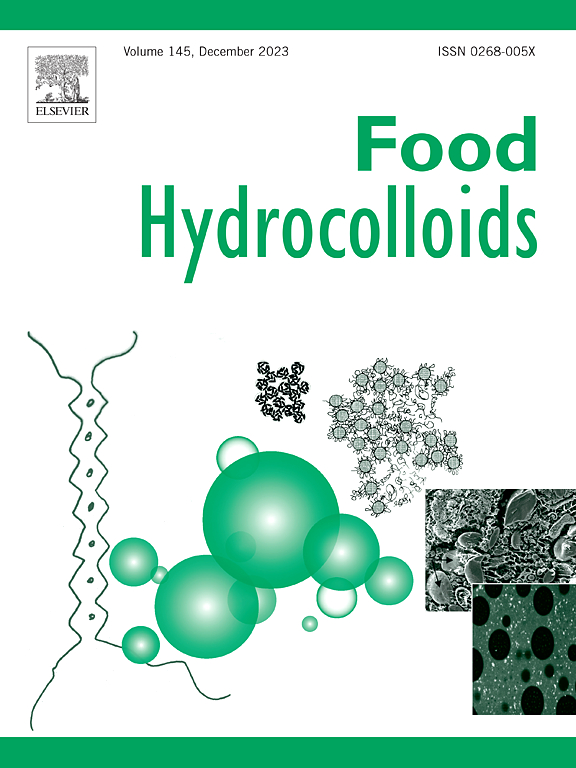One stone, two birds: Preparation of nutritionally fortified and easy-to-swallow 3D printed pea protein gel based on high internal phase emulsions
IF 11
1区 农林科学
Q1 CHEMISTRY, APPLIED
引用次数: 0
Abstract
The elderly often suffered from swallowing difficulties, it is significant to create attractive dysphagia food. Pea protein isolate (PPI) is a promising function-oriented plant protein for the elderly, however, the high viscosity and roughness of PPI gel significantly limited its development and application in 3D printing and dysphagia food. In this study, we constructed high internal phase emulsions with 75 % oil (H-75) as a texture modifier to improve swallowing behavior of PPI gel. The rheological results indicated that PPI gel added H-75 exhibited great printability and low-risk swallowing behavior because of their strong shear thinning, lower viscosity and yield stress, excellent thixotropic behavior that might keep their shape during swallowing without food residue adhering in the tongue and throat. Furthermore, moderate H-75 acted as fillers were uniformly distributed in the gel network and lubricated PPI gel, which resulted in the formation of smoother and softer texture surface that could effectively lock moisture and merge the previous deposited printing layer together. According to the texture and International Dysphagia Diet Standardization Initiative (IDDSI) analysis, the addition of H-75 from 0 % to 8 % significantly decreased friction force (from 16.86 g to 6.97 g) and chewiness (from 173.82 g to 135.57 g) of PPI gel, which could be marked as level 5-minced and moist dysphagia food. In summary, this study could supply a thought and method for developing nutritionally fortified 3D printed PPI gel for the elderly with dysphagia.

一石两鸟:制备营养强化和易于吞咽的3D打印豌豆蛋白凝胶基于高内相乳剂
老年人经常患有吞咽困难,因此制作有吸引力的吞咽困难食品具有重要意义。豌豆分离蛋白(Pea protein isolate, PPI)是一种很有发展前景的老年功能性植物蛋白,但其凝胶的高粘度和粗糙度严重限制了其在3D打印和吞咽困难食品中的发展和应用。在本研究中,我们以75%的油(H-75)作为织构调节剂构建了高内相乳剂,以改善PPI凝胶的吞咽行为。流变学结果表明,加入H-75的PPI凝胶具有较强的剪切减薄性、较低的粘度和屈服应力、良好的触变性,在吞咽过程中可以保持其形状,而不会有食物残渣附着在舌头和喉咙上,具有良好的印刷性和低风险吞咽行为。此外,适量的H-75作为填料均匀分布在凝胶网络和润滑的PPI凝胶中,形成更光滑、更柔软的纹理表面,可以有效地锁湿,并将之前沉积的打印层融合在一起。根据质地及国际吞咽困难饮食标准化倡议组织(IDDSI)的分析,H-75添加量从0%增加到8%后,PPI凝胶的摩擦力(从16.86 g减少到6.97 g)和嚼劲(从173.82 g减少到135.57 g)显著降低,可标记为5级细碎湿润的吞咽困难食品。综上所述,本研究可为老年吞咽困难患者营养强化3D打印PPI凝胶的研制提供思路和方法。
本文章由计算机程序翻译,如有差异,请以英文原文为准。
求助全文
约1分钟内获得全文
求助全文
来源期刊

Food Hydrocolloids
工程技术-食品科技
CiteScore
19.90
自引率
14.00%
发文量
871
审稿时长
37 days
期刊介绍:
Food Hydrocolloids publishes original and innovative research focused on the characterization, functional properties, and applications of hydrocolloid materials used in food products. These hydrocolloids, defined as polysaccharides and proteins of commercial importance, are added to control aspects such as texture, stability, rheology, and sensory properties. The research's primary emphasis should be on the hydrocolloids themselves, with thorough descriptions of their source, nature, and physicochemical characteristics. Manuscripts are expected to clearly outline specific aims and objectives, include a fundamental discussion of research findings at the molecular level, and address the significance of the results. Studies on hydrocolloids in complex formulations should concentrate on their overall properties and mechanisms of action, while simple formulation development studies may not be considered for publication.
The main areas of interest are:
-Chemical and physicochemical characterisation
Thermal properties including glass transitions and conformational changes-
Rheological properties including viscosity, viscoelastic properties and gelation behaviour-
The influence on organoleptic properties-
Interfacial properties including stabilisation of dispersions, emulsions and foams-
Film forming properties with application to edible films and active packaging-
Encapsulation and controlled release of active compounds-
The influence on health including their role as dietary fibre-
Manipulation of hydrocolloid structure and functionality through chemical, biochemical and physical processes-
New hydrocolloids and hydrocolloid sources of commercial potential.
The Journal also publishes Review articles that provide an overview of the latest developments in topics of specific interest to researchers in this field of activity.
 求助内容:
求助内容: 应助结果提醒方式:
应助结果提醒方式:


